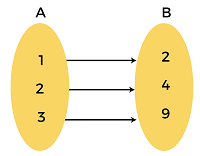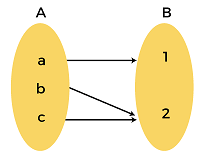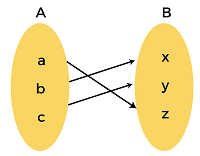Bijective Function in Discrete Mathematics
The bijective function can also be called a one-to-one corresponding function or bijection. One to one function (injection function) and one to one correspondence both are different things. So we should not be confused about these. A function will be known as bijection function if a function f: X → Y satisfied the properties of surjective function (onto function) and injective function (one to one function) both.
In bijection, every element of a set has its partner, and no one is left out. So we can say that the members of the set have the perfect “one to one correspondence”. The bijection function can also be called inverse function as they contain the property of inverse function. The symbol f-1 is used to denote the inverse of a bijection. In the inverse function, every ‘b’ has a matching ‘a’, and every ‘a’ goes to a unique ‘b’ that means f(a) = b. Hence f-1(b) = a.
Properties of Bijective Function
If a bijective function contains a function f: X → Y, then every function of x ∈ X and every function of y ∈ Y such that f(x) = y. So we can say that the element ‘a’ is the preimage of element ‘b’. Same as element ‘b’ is the image of element ‘a’. Now we will learn the basic property of bijective function, which is described as follows:
If we are trying to map two functions, X and Y, then it will become bijective if it contains the following properties:
- Each and every X’s element must pair with at least one Y’s element.
- X’s element may not pair with more than one Y’s element.
- Each and every Y’s element must pair with at least one X’s element.
- Y’s element may not pair with more than one X’s element.
Difference:
Here we will learn about the difference between injective (one to one), surjective (onto), and bijective (one to one correspondence), which is described as follows:
| S.No. | Injective Function | Surjective Function | Bijective Function |
|---|---|---|---|
| 1 | A function will be injective if the distinct element of domain maps the distinct elements of its codomain. | A function will be surjective if one more than one element of A maps the same element of B. | Bijective function contains both injective and surjective functions. |
| 2 | This function can also be called a one-to-one function. | This function can also be called an onto function. | This function can also be called as one to one correspondence. |
| 3 |  |  |  |
Prove that Functions are Bijective
In this section, we will prove that the described functions are bijective or not. If we need to determine the bijection between two, then first we will define a map f: A → B. After that, we will conclude |A| = |B| to show that f is a bijection. We can prove that function f is bijective with the help of writing the inverse for f, or we can say it in two steps, which are described as follows:
- f is surjective
- f is injective
If we have two sets A, and B, and they have the same size, in this case, there will be no bijection between the sets, and the function will be not bijective. Bijection can be described as a “pairing up” of the element of domain A with the element of codomain B. In fact, there will be n! bijections between A and B if |A| = |B| = n.
Examples of Bijective function
Here we will explain various examples of bijective function.
Example 1:
In this example, we have to prove that function f(x) = 3x – 5 is bijective from R to R.
Solution:
On the basis of bijective function, a given function f(x) = 3x -5 will be a bijective function if it contains both surjective and injective functions.
Prove that Function is injective
If we want to show that the given function is injective, then we have prove that f(a) = c and f(b) = c then a = b.
For this, we will assume that
Therefore, we can write it like this:
Thus, we can write it like this:
When we simplify this equation, then we will get the following:
So, we can say that the given function f(x)= 3x -5 is injective.
Prove that Function is Surjective
If we want to show that a given function is surjective, then we have to first show that in the range for any point ‘a’ there exists a point ‘b’ in subdomain ‘s’. That means f(b) = a.
For this, we will assume that
Therefore, the value of b will be like this:
Since, the above number is a real number, and it is also shown in the domain. So we can say that the function is surjective.
Thus, the function f(x) = 3x – 5 satisfies the condition of onto function and one to one function. So we can say that the given function is bijective.
Example 2:
In this example, we will have a function f: A → B, where set A = {x, y, z} and B = {a, b, c}. We have to prove that this function is bijective or not.
Solution:
As we know f: A → B such that
As we can see that the above function satisfies the property of onto function and one to one function. That’s why the given function is a bijective function.
Example 3:
In this example, we have to prove that the function f(x) = x2 is a bijective function or not from the set of positive real numbers.
Solution:
For the positive real numbers, the given function f(x) = x2 is both injective and surjective. That’s why it is also bijective.
But for all the real numbers R, the same function f(x) = x2 has the possibilities 2 and -2. So f(2) = 4 and f(-2) = 4, which does not satisfy the property of bijective. That’s why we can say that for all real numbers, the given function is not bijective.
Example 4:
In this example, we have to prove that the function f: {month of a year} {1, 2, 3, 4, 5, 6, 7, 8, 9, 10, 11, 12}is a bijective function or not.
Solution:
The given function will be bijective if we define the function as f(M) = the number ‘n’ such that M is used to define the nth month.
